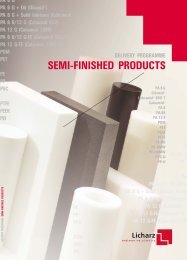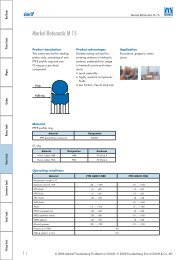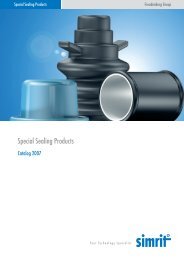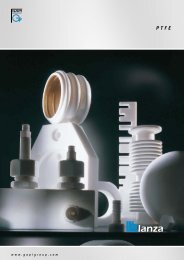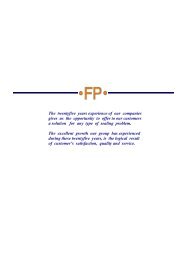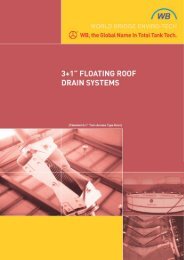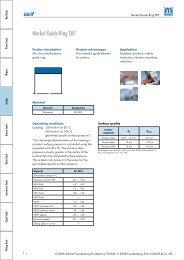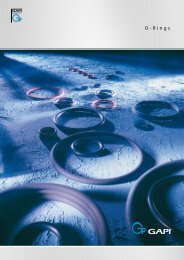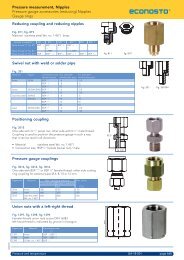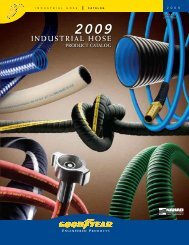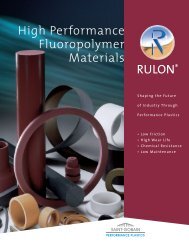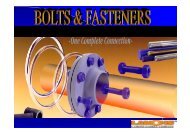Spaghetti in PTFE
Spaghetti in PTFE
Spaghetti in PTFE
You also want an ePaper? Increase the reach of your titles
YUMPU automatically turns print PDFs into web optimized ePapers that Google loves.
P T F E
IndiceContents<strong>PTFE</strong> 5Proprietà del <strong>PTFE</strong> 6<strong>PTFE</strong> 5Properties of <strong>PTFE</strong> 61 Proprietà termiche 61.1 Stabilità termica 61.2 Punti di transizione 61.3 Dilatazione 71.4 Conducibilità termica 71.5 Calore specifico 72 Comportamenti nei confronti di agenti esterni2.1 Resistenza ai reagenti chimici 72.2 Resistenza ai solventi 72.3 Resistenza agli agenti atmosferici e alla luce 72.4 Resistenza alle radiazioni 82.5 Permeabilità ai gas 83 Proprietà fisico - meccaniche3.1 Resistenza a trazione e a compressione 83.2 Resistenza alla flessione 93.3 Resistenza all’urto (resilienza) 93.4 Memoria plastica 93.5 Durezza 93.6 Attrito 93.7 Usura 104 Proprietà elettriche4.1 Rigidità dielettrica 104.2 Costante dielettrica e fattore di dissipazione 114.3 Resistenza all’arco 114.4 Resistenza all’effetto corona 115 Proprietà di superficie 116 Tolleranze dimensionali 111 Thermal properties 61.1 Thermal Stability 61.2 Transition po<strong>in</strong>ts 61.3 Expansion 71.4 Thermal conductivity 71.5 Specific heat 72 Behaviour <strong>in</strong> presence of foreign agents2.1 Resistance to chemical agents 72.2 Solvent resistance 72.3 Resistance to atmospheric agents and light 72.4 Resistance to radiation 82.5 Gas permeability 83 Physical - mechanical properties3.1 Tensile and compressive properties 83.2 Flexibility 93.3 Impact properties 93.4 Plastic memory 93.5 Hardness 93.6 Friction 93.7 Wear 104 Electrical properties4.1 Dielectric strength 104.2 Dielectric constant and dissipation factor 114.3 Arc-resistance 114.4 Corona effect resistance 115 Surface properties 116 Dimensional tolerances 112<strong>PTFE</strong>
<strong>PTFE</strong> Caricato 13Proprietà del <strong>PTFE</strong> caricato 141 Funzioni delle cariche 141.1 Fibre di vetro 141.2 Carbone 141.3 Bronzo 141.4 Grafite 151.5 Altre cariche 152 Proprietà fisico - meccaniche 152.1 Usura 152.2 Deformazione sotto caricoe resistenza alla compressione 163 Proprietà termiche 164 Proprietà elettriche 175 Tolleranze dimensionali 17Tondi estrusi <strong>in</strong> <strong>PTFE</strong> 22Tondi stampati <strong>in</strong> <strong>PTFE</strong> 23Tubi estrusi <strong>in</strong> <strong>PTFE</strong> 24Manicotti stampati <strong>in</strong> <strong>PTFE</strong> 26Nastri sfogliati 28Lastre 29<strong>Spaghetti</strong> <strong>in</strong> <strong>PTFE</strong> 30Tubi a parete sottile 32Saturflon vetro 34Tond<strong>in</strong>i non s<strong>in</strong>terizzati <strong>in</strong> <strong>PTFE</strong> 35Guarnizioni <strong>in</strong> <strong>PTFE</strong> espanso 36Filled <strong>PTFE</strong> 13Properties of filled <strong>PTFE</strong> 141 Filler functions 141.1 Glass fiber 141.2 Carbon 141.3 Bronze 141.4 Graphite 151.5 Other fillers 152 Physical - mechanical properties 152.1 Wear 152.2 Deformation under load and compressivestrength 163 Thermal properties 164 Electrical properties 175 Dimensional tolerances 17<strong>PTFE</strong> extruded rods 22<strong>PTFE</strong> moulded rods 23<strong>PTFE</strong> extruded tubes 24<strong>PTFE</strong> moulded tubes 26Skived tapes 28Sheets 29<strong>PTFE</strong> <strong>Spaghetti</strong> tub<strong>in</strong>g 30Th<strong>in</strong>-wall tub<strong>in</strong>g 32Saturflon glass 34<strong>PTFE</strong> Uns<strong>in</strong>tered cord 35Expanded <strong>PTFE</strong> sealant 36<strong>PTFE</strong> 3
4<strong>PTFE</strong>
<strong>PTFE</strong>Il politetrafluoroetilene (<strong>PTFE</strong>) è un polimero ad altissimopeso molecolare, costituito da atomi di Fluoro e di Carbonioche lo rendono una fra le materie plastiche più versatiliconsigliandolo per impieghi preclusi ad altri materiali.Fra le caratteristiche più <strong>in</strong> evidenza:- elevata resistenza termica- elevata resistenza agli agenti chimici e solventi- elevata antiadesività- elevate caratteristiche dielettriche- basso coefficiente di attrito- atossicità.Polytetrafluoroethylene (<strong>PTFE</strong>) is a high molecular weightpolymer, one of the most versatile plastic materials knownand useful for a large range of products for applicationsexcluded to other materials.The most outstand<strong>in</strong>g characteristics are:- high heat resistance- high resistance to chemical agents and solvents- high antiadhesiveness- high dielectric properties- low friction coefficient- non-toxicity.Il <strong>PTFE</strong> viene generalmente considerato come un polimerotermoplastico; esso, a 327°C circa, conserva ancora unaelevata viscosità, per cui sono richieste particolari tecnichedi trasformazione per la realizzazione di pezzi f<strong>in</strong>iti e semilavorati.Campo di impiego con temperature da -200°C a +260°C.<strong>PTFE</strong> is generally considered a thermoplastic polymer; at327°C it reta<strong>in</strong>s a very high viscosity, thus requir<strong>in</strong>g particulartransformation techniques for manufactur<strong>in</strong>g of f<strong>in</strong>ishedand semi-f<strong>in</strong>ished goods.<strong>PTFE</strong> can be used <strong>in</strong> a temperature range from -200°C to+260°C.GAPI, da oltre 35 anni, ha maturato un’esperienza che leconsente di seguire le tecniche di lavorazione più razionali,di applicare metodi di controllo dei processi produttivi edelle produzioni più appropriati, garanzia di una elevataqualità dei prodotti <strong>PTFE</strong>.Dur<strong>in</strong>g more than 35 years, GAPI has developed manufactur<strong>in</strong>gprocesses and production control techniques to <strong>in</strong>surethe highest quality <strong>PTFE</strong> products <strong>in</strong> the market.<strong>PTFE</strong> 5
Proprietà del <strong>PTFE</strong>Properties of <strong>PTFE</strong>Nella tabella 1 sono riportati i valori tipici delle caratteristichefisiche del <strong>PTFE</strong> riferibili a pezzi ottenuti per stampaggio,determ<strong>in</strong>ati secondo i metodi <strong>in</strong>dicati.Table 1 shows the physical properties of moulded <strong>PTFE</strong>,methods for determ<strong>in</strong><strong>in</strong>g these values are listed.1 Proprietà termiche1 Thermal properties1.1 Stabilità termicaIl <strong>PTFE</strong> è una delle materie plastiche termicamente più stabili.A 260°C non si hanno apprezzabili decomposizioni, percui a questa temperatura il <strong>PTFE</strong> conserva ancora buonaparte delle proprie caratteristiche. Decomposizioni apprezzabilisi rilevano oltre i 400°C.1.1 Thermal stability<strong>PTFE</strong> is one of the most thermally stable plastic material.There is no appreciable decomposition at 260°C, so that<strong>PTFE</strong>, at this temperature, still possesses the greater part ofits properties.Appreciable decomposition beg<strong>in</strong>s at over 400°C.1.2 Punti di transizioneLa disposizione delle molecole del <strong>PTFE</strong> (struttura cristall<strong>in</strong>a)varia al variare della temperatura. I punti di transizionepiù importanti sono due: quello a 19°C a cui corrispondeuna variazione di alcune caratteristiche fisiche e quello a327°C a cui corrisponde la scomparsa della fase cristall<strong>in</strong>a:il <strong>PTFE</strong> assume aspetto amorfo, conservando tuttavia ancorala propria forma geometrica.1.2 Transition po<strong>in</strong>tsThe arrangement of the <strong>PTFE</strong> molecules varies with thetemperature. There are different transition po<strong>in</strong>ts, with themost important ones be<strong>in</strong>g the follow<strong>in</strong>g: at 19°C correspond<strong>in</strong>gto a modification of some physical properties andthat at 327°C which corresponds to the disappearance ofthe crystall<strong>in</strong>e structure: the <strong>PTFE</strong> assumes an amorphousaspect conserv<strong>in</strong>g its own geometric form.dilatazione %expansion coefficient %coefficiente di dilatazioneexpansion coefficient °C –1 x 10 –5Fig. 1Dilatazione termica l<strong>in</strong>eare e coefficiente di dilatazione del <strong>PTFE</strong><strong>in</strong> funzione della temperatura<strong>PTFE</strong> l<strong>in</strong>ear thermal expansion and expansion coefficient vs. temperatureTemperatura °CTemperature °C6<strong>PTFE</strong>
1.3 DilatazioneIl coefficiente di dilatazione l<strong>in</strong>eare varia al variare dellatemperatura; <strong>in</strong>oltre, a causa dell’orientamento dovuto allalavorazione, i pezzi <strong>in</strong> <strong>PTFE</strong> sono <strong>in</strong> genere anisotropi; nederiva che il coefficiente di dilatazione è <strong>in</strong> funzione anchedella direzione.1.3 ExpansionThe l<strong>in</strong>ear thermal expansion coefficient varies with thetemperature. In addition, because of the orientation causedby the work<strong>in</strong>g process, the <strong>PTFE</strong> pieces are <strong>in</strong> general anisotropic;<strong>in</strong> other words, the coefficient of expansion variesalso <strong>in</strong> relation to direction.1.4 Conducibilità termicaIl coefficiente di conducibilità termica del <strong>PTFE</strong> non varia colvariare della temperatura ed è relativamente elevato, percui il <strong>PTFE</strong> deve considerarsi un buon isolante. L’aggiunta diuna opportuna carica migliora la conducibilità termica(vedasi <strong>PTFE</strong> caricato).1.4 Thermal conductivityThe coefficient of the thermal conductivity of <strong>PTFE</strong> does notvaries with the temperature. It is relatively high, so that <strong>PTFE</strong>can be considered to be a good <strong>in</strong>sulat<strong>in</strong>g material. Themix<strong>in</strong>g of suitable fillers improves the thermal conductivity(see filled <strong>PTFE</strong>).1.5 Calore specificoIl calore specifico, come pure il contenuto termico (entalpia),aumenta all’aumentare della temperatura.1.5 Specific heatThe specific heat, as well as the heat content (enthalpy)<strong>in</strong>creases with the temperature.2 Comportamento nei confrontidi agenti esterni2 Behaviour <strong>in</strong> presence offoreign agents2.1 Resistenza ai reagenti chimiciIl <strong>PTFE</strong> è praticamente <strong>in</strong>erte nei confronti dei composti edegli elementi f<strong>in</strong>ora noti. Esso viene attaccato solo damateriali alcal<strong>in</strong>i allo stato elementare, dal Trifluoruro diCloro e dal Fluoro elementare a temperature e pressionielevate.2.1 Resistance to chemical agents<strong>PTFE</strong> is practically <strong>in</strong>ert aga<strong>in</strong>st known elements and compounds.It is attacked only by the alkal<strong>in</strong>e metals <strong>in</strong> the elementarystate, by Chlor<strong>in</strong>e trifluoride and by elementaryFluor<strong>in</strong>e at high temperatures and pressures.2.2 Resistenza ai solventiIl <strong>PTFE</strong> è <strong>in</strong>solubile <strong>in</strong> qualsiasi solvente f<strong>in</strong>o alla temperaturadi circa 300°C. Gli idrocarburi fluorurati provocano uncerto rigonfiamento ma <strong>in</strong> maniera reversibile; alcuni oliialtamente fluorurati, a temperatura oltre i 300°C, esercitanouna certa azione solvente sul <strong>PTFE</strong>.2.2 Solvent resistance<strong>PTFE</strong> is <strong>in</strong>soluble <strong>in</strong> almost all solvents at temperatures up toabout 300°C. Fluor<strong>in</strong>ated hydrocarbons cause a certa<strong>in</strong>swell<strong>in</strong>g which is however reversible; some highly fluor<strong>in</strong>atedoils, at temperatures over 300°C, exercise a certa<strong>in</strong> dissolv<strong>in</strong>geffect upon <strong>PTFE</strong>.2.3 Resistenza agli agenti atmosferici e alla luceProv<strong>in</strong>i di <strong>PTFE</strong>, esposti ormai da più di vent’anni alle condizioniclimatiche più disparate, non hanno ancora dimostratoalcuna alterazione delle proprie caratteristiche.2.3 Resistance to atmospheric agents and lightTest pieces of <strong>PTFE</strong>, exposed for over twenty years to themost disparate climatic conditions, have not shown anyalteration of their characteristic properties.<strong>PTFE</strong> 7
2.4 Resistenza alle radiazioniLe radiazioni tendono a provocare la rottura della molecoladel <strong>PTFE</strong>, per cui la resistenza alle radiazioni del <strong>PTFE</strong> risultarelativamente modesta.2.4 Resistance to radiationHigh energy radiation tend to cause the break<strong>in</strong>g of the<strong>PTFE</strong> molecule, so that the resistance of the product toradiations is rather poor.2.5 Permeabilità ai gasLe caratteristiche di permeabilità del <strong>PTFE</strong> sono quelle dellealtre materie plastiche. La permeabilità oltre a dipendere,ovviamente, dallo spessore e dalla pressione, dipendeanche dalle tecniche di lavorazione del <strong>PTFE</strong>.2.5 Gas permeabilityThe permeability of <strong>PTFE</strong> is similar to other plastic materials.The permeability does not depend only on the thicknessand pressure, but also on the work<strong>in</strong>g techniques.3 Proprietà fisico - meccaniche3 Physical - mechanical properties3.1 Resistenza a trazione e a compressioneQueste caratteristiche sono <strong>in</strong> larga misura <strong>in</strong>fluenzate daicicli di lavorazione e dal tipo di polvere impiegata. Il <strong>PTFE</strong>può essere impiegato <strong>in</strong> servizio cont<strong>in</strong>uo f<strong>in</strong>o a 260°C,mentre a temperature prossime allo Zero assoluto possiedeancora una certa plasticità a compressione.3.1 Tensile and compressive propertiesThese properties are to a large degree <strong>in</strong>fluenced by thework<strong>in</strong>g processes and the polymer used. <strong>PTFE</strong>, however,can be used cont<strong>in</strong>uously at temperatures up to 260°C,while possess<strong>in</strong>g still a certa<strong>in</strong> compressive plasticity attemperatures near to the absolute Zero.Resistenza a trazione N/mm 2Tensile strength N/mm 2Fig. 2Diagramma resistenza a trazione-allungamentoa rottura del <strong>PTFE</strong><strong>PTFE</strong> tensile strength vs elongationAllungamento a rottura %Elongation %8<strong>PTFE</strong>
3.2 Resistenza alla flessioneIl <strong>PTFE</strong> è relativamente flessibile e non si rompe quandoviene sollecitato a 0,7 N/mm 2 secondo ASTM D 790. Ilmodulo di elasticità a flessione si aggira <strong>in</strong>torno a 350÷650N/mm 2 a temperatura ambiente, circa 2000 N/mm 2 a-80°C, circa 200 N/mm 2 a 100°C e circa 45 N/mm 2 a260°C.3.3 Resistenza all’urto (resilienza)Il <strong>PTFE</strong> possiede elevate caratteristiche di resilienza anchea basse temperature (vedi tabella 1).3.2 Flexibility<strong>PTFE</strong> is quite flexible and does not break when subjected tostresses of 0,7 N/mm 2 accord<strong>in</strong>g to ASTM D 790. Flexuralmodulus is about 350 to 650 N/mm 2 at room temperature,about 2000 N/mm 2 at -80°C, about 200 N/mm 2 at 100°Cand about 45 N/mm 2 at 260°C.3.3 Impact properties<strong>PTFE</strong> possesses very high resilience characteristics at lowtemperatures (see table 1).3.4 Memoria plasticaSe un pezzo di <strong>PTFE</strong> viene sollecitato a trazione o a compressione,al di sotto del limite di snervamento, parte delledeformazioni provocate permangono al cessare delle sollecitazioni(deformazioni permanenti) così che, nel pezzorisultano <strong>in</strong>dotte delle tensioni.Se il pezzo viene riscaldato, queste tensioni tendono a liberarsie il pezzo riassume la forma <strong>in</strong>iziale. Questa proprietàdel <strong>PTFE</strong> è comunemente <strong>in</strong>dicata come “memoria plastica”ed è sfruttata <strong>in</strong> diverse applicazioni.Anche la maggior parte dei semilavorati, a causa dei processidi trasformazione, possiede <strong>in</strong> una certa misura,simili tensioni. Se si vuole avere semilavorati dimensionalmentestabili alle alte temperature, si può sottoporli a280°C per 1 ora ogni 6 mm di spessore e raffreddarli poilentamente. I semilavorati così ottenuti sono quasi privi ditensioni <strong>in</strong>terne e sono noti come “condizionati” o “termostabilizzati”.3.4 Plastic memoryIf a piece of <strong>PTFE</strong> is subjected to tensile or compressionstresses below the yield po<strong>in</strong>t, part of the result<strong>in</strong>g deformationsrema<strong>in</strong> (as permanent deformations) after the discont<strong>in</strong>uanceof the stresses, with the result that certa<strong>in</strong> stra<strong>in</strong>sare <strong>in</strong>duced <strong>in</strong> the piece. If the piece is reheated, thesestra<strong>in</strong>s tend to release themselves with<strong>in</strong> the piece whichresumes its orig<strong>in</strong>al form. This property of the <strong>PTFE</strong> is commonly<strong>in</strong>dicated as “plastic memory” and is made use of <strong>in</strong>different applications.Also the greater part of the semi-f<strong>in</strong>ished products, becauseof the transformation processes, possesses similar stra<strong>in</strong>s, toa certa<strong>in</strong> degree. When it is desired to obta<strong>in</strong> semi-f<strong>in</strong>ishedparts dimensionally stable at high temperatures, it is possibleto subject the parts to a temperature of 280°C for onehour every 6 mm of thickness and then cool them slowly.The parts obta<strong>in</strong>ed <strong>in</strong> this manner are almost completelyfree from <strong>in</strong>ternal stra<strong>in</strong>s and are <strong>in</strong> general known as “conditioned”or “thermostabilised” material.3.5 DurezzaLa durezza Shore D misurata secondo il metodo ASTM D2240 ha valori compresi fra D50 e D60. Mentre, secondo lanorma DIN 53456, la durezza è compresa fra 27 e 32 N/mm 2 .3.5 HardnessThe hardness Shore D, measured accord<strong>in</strong>g to the methodASTM D 2240, has values comprised between D50 and D60.Accord<strong>in</strong>g DIN 53456 (load 13,5 Kg for 30 sec) results <strong>in</strong> anhardness range between 27 and 32 N/mm 2 .3.6 AttritoIl <strong>PTFE</strong> possiede, fra tutti i materiali solidi, i più bassi coefficientidi attrito compresi fra valori di 0,05 e 0,09:- il coefficiente di attrito statico (di primo distacco) e quellod<strong>in</strong>amico sono uguali per cui non si verificano fenomenidi grippaggio e di attrito allo spunto3.6 Friction<strong>PTFE</strong> possesses the lowest friction coefficients of all solidmaterials, between 0.05 and 0.09:- the static and dynamic friction coefficients are almostequal, so that there is no seizure or stick-slip action<strong>PTFE</strong> 9
- aumentando il carico, il coefficiente di attrito dim<strong>in</strong>uisceper poi stabilizzarsi- il coefficiente di attrito aumenta con l’aumentare dellavelocità- il coefficiente di attrito rimane costante al variare dellatemperatura.- when <strong>in</strong>creas<strong>in</strong>g the load, the friction coefficient decreasesuntil reach<strong>in</strong>g a stable value- the friction coefficient <strong>in</strong>creases with the speed- the friction coefficient rema<strong>in</strong>s constant at temperaturevariations.3.7 UsuraL’usura dipende dalla condizione dell’altra superficie discorrimento ed è ovviamente <strong>in</strong> funzione della velocità e deicarichi. L’usura viene notevolmente ridotta addizionando al<strong>PTFE</strong> opportune cariche (vedasi <strong>PTFE</strong> caricato).3.7 WearThe wear depends upon the condition of the other slid<strong>in</strong>gsurface and obviously depends upon the speed and loads.The wear is considerably reduced when add<strong>in</strong>g suitable fillersto the <strong>PTFE</strong> (see filled <strong>PTFE</strong>).Coefficiente attrito d<strong>in</strong>amicoDynamic friction coefficientFig. 3Influenza della velocità sul coefficiente di attrito d<strong>in</strong>amicoInfluence of slid<strong>in</strong>g velocity on dynamic friction coefficientV (m/mm)4 Proprietà elettricheIl <strong>PTFE</strong> è un buon isolante e un prezioso dielettrico, comedimostrano i dati <strong>in</strong> proposito riportati nella tabella 1. Essomantiene praticamente queste sue caratteristiche <strong>in</strong> unampio campo di condizioni ambientali, di temperature e difrequenza.4 Electrical properties<strong>PTFE</strong> is an excellent <strong>in</strong>sulator and excellent dielectric asshown by the relative data reported <strong>in</strong> table 1, and ma<strong>in</strong>ta<strong>in</strong>sthese characteristics throughout a large range of environmentalconditions, temperatures and frequencies.4.1 Rigidità dielettricaLa rigidità dielettrica del <strong>PTFE</strong> varia al variare dello spessoree dim<strong>in</strong>uisce con l’aumentare della frequenza. Rimane praticamentecostante f<strong>in</strong>o a 300°C e non varia nemmeno dopoprolungato trattamento ad elevate temperature (6 mesi a300°C). Dipende <strong>in</strong> buona misura dai processi di lavorazione.4.1 Dielectric strengthThe dielectric strength of <strong>PTFE</strong> varies with the thicknessand decreases with <strong>in</strong>creas<strong>in</strong>g frequency. It rema<strong>in</strong>s praticallyconstant up to 300°C and does not vary even after aprolonged treatment at high temperatures (6 months at300°C). It depends also upon the transformation processes.10<strong>PTFE</strong>
4.2 Costante dielettrica e fattore di dissipazioneIl <strong>PTFE</strong> possiede valori di costante dielettrica e di fattore didissipazione molto bassi; essi rimangono <strong>in</strong>variati f<strong>in</strong>o a300°C, <strong>in</strong> un campo di frequenze f<strong>in</strong>o a 10 9 Hz e anchedopo prolungato trattamento termico (6 mesi a 300°C).Costante dielettrica e fattore di dissipazione, così come laresistività di volume e di superficie, si possono considerare<strong>in</strong>dipendenti dai processi di lavorazione.4.2 Dielectric constant and dissipation factor<strong>PTFE</strong> has very low dielectric constant and dissipation factorsvalues; these rema<strong>in</strong> constant up to 300°C, <strong>in</strong> a frequencyfield of up to 10 9 Hz even after a prolonged thermal treatment(6 months at 300°C). The dielectric constant, dissipationfactor as well as the volume resistivity and surface resistivitymay be considered as be<strong>in</strong>g <strong>in</strong>dependent from thetransformation processes.4.3 Resistenza all’arcoIl <strong>PTFE</strong> possiede una buona resistenza all’arco. Il tempo diresistenza all’arco secondo ASTM D 495 è di 700 sec..Anche dopo azione prolungata, non si notano però carbonizzazionidelle superfici.4.3 Arc-resistance<strong>PTFE</strong> has a good resistance to the arc. The arc resistancetime accord<strong>in</strong>g to ASTM D 495 is 700 sec..After a prolonged exposure there are no signs of surfacechar<strong>in</strong>g.4.4 Resistenza all’effetto coronaLe scariche dell’effetto corona possono anche provocareerosioni alle superfici del <strong>PTFE</strong> che viene comunemente<strong>in</strong>dicato come isolante idoneo <strong>in</strong> caso di elevate differenzedi potenziale.4.4 Corona effect resistanceThe discharges caused by the corona effect may result <strong>in</strong>erosions of the <strong>PTFE</strong> surface which, nevertheless, is <strong>in</strong>dicatedas a suitable <strong>in</strong>sulator <strong>in</strong> case of high potential differences.5 Proprietà di superficieLa configurazione molecolare del <strong>PTFE</strong> conferisce allesuperfici un’elevata antiadesività; sempre per lo stessomotivo le sue superfici risultano difficilmente bagnabili:l’angolo di contatto con l’acqua è 110° ca. e si può affermareche, oltre una tensione superficiale di 20 d<strong>in</strong>e/cm, iliquidi non bagnano più il <strong>PTFE</strong>. Un trattamento speciale,chiamato impropriamente cementazione, rende le superficicollabili e bagnabili.5 Surface propertiesThe molecular configuration of <strong>PTFE</strong> br<strong>in</strong>gs to its surfaces ahigh anti-adhesiveness. For the same reason these surfacesare hardly wettable, the contact angle with water is about110° and it is possible to affirm that, beyond a surface tensionof 20 d<strong>in</strong>e/cm, the liquid no longer wets the <strong>PTFE</strong>.A special etch<strong>in</strong>g treatment renders the surfaces bondableand wettable.6 Tolleranze dimensionaliLe tolleranze dimensionali riportate nelle tabelle dei semilavorati,si riferiscono al <strong>PTFE</strong> verg<strong>in</strong>e e fanno riferimentoalla Norma ISO 13000-1.I rilievi devono essere effettuati a 23±2°C.6 Dimensional tolerancesDimensional tolerances for basic shapes listed <strong>in</strong> the follow<strong>in</strong>gtables are for virg<strong>in</strong> <strong>PTFE</strong> and refer to standard ISO13000-1.Dimensional tolerances shall be measured at 23±2°C.<strong>PTFE</strong> 11
Tab. 1Pr<strong>in</strong>cipali proprietà del <strong>PTFE</strong> - Typical properties of <strong>PTFE</strong>Proprietà Metodo U.m. Valori tipiciProperty Method Unit Typical valuesPeso specifico - Specific gravity ASTM D 792 - 2,17Carico rottura - Tensile strength ASTM D 1457 N/mm 2 25Allungamento a rottura - Elongation at break ASTM D 1457 % 280Resistenza alla compressione 1% deformaz.Compressive strength 1% deformation ASTM D 695 N/mm 2 4Resistenza alla flessione 0,7 N/mm 2Flexural strength 0,7 N/mm 2 ASTM D 790 N/mm2 Nessuna rotturano breakResistenza all’urto - Impact strength (Izod) 57°C ASTM D 256 J/cm 1,1023°C ASTM D 256 J/cm 1,6077°C ASTM D 256 J/cm 3,30Durezza - Hardness ASTM D 2240 (shore D) 55Coefficiente di attrito - Friction coefficient ASTM D 3028statico - static (1) - 0,09d<strong>in</strong>amico - dynamic (1) - 0,05<strong>PTFE</strong>-acciaio lubrificato con olio - <strong>PTFE</strong>-steel oil-lubricated - - 0,03Campo di impiego - Work<strong>in</strong>g temperature range - °C -200 ÷ +260Aumento di volume da temperatura ambiente a stato fuso (340°C)Increase <strong>in</strong> volume from room temperature to molten state (340°C) % 27Coefficiente di dilatazione - Coefficient of thermal expansionda 25 a 100°C - from 25 to 100°C ASTM E 831 °C -1 16x 10 -5Conducibilità termica - Thermal conductivity ASTM C 177 W/mK 0,20Calore specifico - Specific heat 0°C - KJ/kg.K 0,9650°C - kJ/kg.K 1,05Temperature di distorsione - Temperature of distortion0,46 N/mm 2 ASTM D 648 °C 1301,85 N/mm 2 ASTM D 648 °C 50Rigidità dielettrica (breve durata <strong>in</strong> aria spessore 0,5 mm)Dielectric strength (short-time air thickness 0,5 mm) ASTM D 149 kV/mm 55Costante dielettrica - Dielectric constant (50-10 9 Hz) ASTM D 150 - 2,1Fattore di dissipazione - Dissipation factor ASTM D 150 - < 0,0002Resistività di volume - Volume resistivity ASTM D 257 Ohm/cm 10 17Resistività di superficie - Surface resistivity (2) ASTM D 257 Ohm 10 15Resistenza all’arco - Arc-resistance (420 sec) ASTM D 495 sec OK (3)Assorbimento acqua - Water absorption ASTM D 570 % < 0,01Infiammabilità - Flammability ATB ASTM D 635 sec < 5AEB ASTM D 635 mm < 5Note:Tutti i valori, a meno che non sia diversamente specificato, sono riferiti alla temperatura di 23°C.All the values refer to the temperature of 23°C unless otherwise specified(1) Velocità 5 m/m<strong>in</strong>; carico 1kg/cm 2 , superficie strisciante acciaio rugosità Ra = 0,4 ÷ 0,6 micronSpeed 5 m/m<strong>in</strong>; load 1kg/cm 2 , slid<strong>in</strong>g surface steel roughness Ra = 0,4 ÷ 0,6 micron(2) 100% umidità relativa - 100% relative humidity(3) Senza difetti - without defects12 <strong>PTFE</strong> 1 - Proprietà del <strong>PTFE</strong>
<strong>PTFE</strong> caricatoFilled <strong>PTFE</strong>Il <strong>PTFE</strong>, per le proprietà precedentemente descritte, vieneimpiegato <strong>in</strong> un grandissimo numero di applicazioni. Alcunedi queste proprietà possono essere migliorate e/o modificatemediante l’aggiunta di opportuni additivi. Il <strong>PTFE</strong> cosìadditivato è generalmente conosciuto come <strong>PTFE</strong> caricato.Gli additivi o le cariche maggiormente impiegate sono: fibradi vetro, carbone, bronzo e grafite, sotto forma di polvere<strong>in</strong>timamente miscelata con <strong>PTFE</strong>. Tra gli altri additivi troviamo:il bisolfuro di Molibdeno, le polveri metalliche, la ceramica,gli ossidi metallici e le miscele di additivi.<strong>PTFE</strong>, because of the properties previously described, isused <strong>in</strong> a very large number of fields. Some of its propertiescan be improved and/or modified by add<strong>in</strong>g suitable fillers,allow<strong>in</strong>g the use of <strong>PTFE</strong> <strong>in</strong> fields otherwise precluded tothis polymer. The treated <strong>PTFE</strong> is generally known as filled<strong>PTFE</strong>. The fillers most commonly used are: glass fiber, carbon,bronze or graphite, <strong>in</strong> the form of powder <strong>in</strong>timatelymixed with the <strong>PTFE</strong>; other fillers are: molybdenum disulfide,metal powders, ceramics, metal oxides and mixtures oftwo or more additives.L’aggiunta di cariche al <strong>PTFE</strong> migliora o modifica le proprietà<strong>in</strong> misura che dipende dalla natura e dalla quantità dellacarica:- aumenta notevolmente la resistenza all’usura- dim<strong>in</strong>uisce le deformazioni sotto carico e lo scorrimentoplastico- dim<strong>in</strong>uisce la dilatazione termica- alcuni tipi di cariche aumentano la conducibilità termicaed elettrica.Si ha una flessione delle caratteristiche a trazione e di resilienzamentre la carica condiziona la resistenza agli agentichimici e le caratteristiche elettriche.The addition of fillers to the <strong>PTFE</strong> improves or modifies itsproperties depend<strong>in</strong>g upon the nature and quantity of filler:- remarkable <strong>in</strong>crease <strong>in</strong> wear resistance- decrease of deformation under load and of creep- reduction of thermal expansion- some types of filler <strong>in</strong>crease the thermal and electric conductivity.Filled <strong>PTFE</strong> is often not as strong and resilient as virg<strong>in</strong><strong>PTFE</strong>. The filler limits the resistance to chemical agents andthe electrical properties.1 - <strong>PTFE</strong> caricato – Filled <strong>PTFE</strong> 13
Proprietà del <strong>PTFE</strong> caricatoProperties of filled <strong>PTFE</strong>Nella tabella 2 sono riportati i valori tipici delle caratteristichefisiche dei tipi di <strong>PTFE</strong> caricato. Anche questi valorisono riferibili, <strong>in</strong> generale, a pezzi stampati, sono statideterm<strong>in</strong>ati secondo i metodi <strong>in</strong>dicati e non possono pertantoessere considerati <strong>in</strong> assoluto; essi consentono tuttaviaun confronto delle caratteristiche di ogni tipo rispettoall’altro.Table 2 shows the typical physical properties of filled <strong>PTFE</strong>.These values refer to molded material and have been determ<strong>in</strong>edaccord<strong>in</strong>g to the listed methods.1 Funzioni delle cariche1 Filler functions1.1 Fibre di vetroIl <strong>PTFE</strong> viene caricato, con fibre di vetro <strong>in</strong> percentuali <strong>in</strong>peso variabili fra il 5 e il 40%. Il vetro migliora le caratteristichedi usura e, <strong>in</strong> misura m<strong>in</strong>ore, quelle di deformazionesotto carico, lasciando sostanzialmente <strong>in</strong>alterate le caratteristicheelettriche e chimiche. Il vetro possiede scarsaresistenza chimica agli alcali e può essere attaccato dall’acidofluoridrico. Aumenta leggermente il coefficiente di attrito,e per questa ragione viene talvolta aggiunta della grafiteche ne compensa gli effetti.1.1 Glass fiber<strong>PTFE</strong> is re<strong>in</strong>forced with glass fibers, the percentage vary<strong>in</strong>gbetween 5 and 40%. The added glass fiber improves thewear properties and, to a m<strong>in</strong>or degree, also the deformationstrength under load while leav<strong>in</strong>g substantially unchangedthe electrical and chemical characteristics. Glass itself,has a rather poor resistance aga<strong>in</strong>st alkalis and is easily attackedby hydrofluoric acid. The coefficient of friction is slightly<strong>in</strong>creased and for this reason, graphite is sometimesadded to compensate this side effect.1.2 CarboneIl <strong>PTFE</strong> viene caricato con carbone <strong>in</strong> percentuale <strong>in</strong> pesocompreso fra il 10 e 35% unitamente a piccole percentualidi grafite. Anche il carbone migliora notevolmente le caratteristichedi usura e di deformazione sotto carico, aumentala conducibilità termica, lascia praticamente <strong>in</strong>alterate lecaratteristiche di resistenza chimica, mentre modificasostanzialmente le caratteristiche elettriche.1.2 CarbonCarbon is added to the <strong>PTFE</strong> <strong>in</strong> a percentage by weightbetween 10 and 35%, along with small percentage of graphite.Also, the carbon tends to improve to a considerabledegree, wear and deformation strength, while leav<strong>in</strong>g practicallyunchanged the chemical resistance, but substantiallymodify<strong>in</strong>g the electrical properties.1.3 BronzoIl <strong>PTFE</strong> viene caricato con bronzo <strong>in</strong> percentuale <strong>in</strong> pesocompreso fra il 40 e il 60%. I caricati bronzo possiedono lemigliori caratteristiche di usura, notevoli caratteristiche dideformazione sotto carico, hanno una buona conducibilitàtermica mentre possiedono scarse caratteristiche elettrichee di resistenza agli agenti chimici.1.3 BronzeBronze, when used as filler, is added <strong>in</strong> percentages ofweight between 40 and 60%. Bronze filled <strong>PTFE</strong> has the bestwear properties, remarkable deformation strengths andgood thermal conductivity, but poor electrical characteristicsand chemical resistance.14<strong>PTFE</strong>
1.4 GrafiteIl <strong>PTFE</strong> viene caricato con grafite <strong>in</strong> percentuali compresefra il 5 e il 15%. La grafite abbassa il coefficiente di attrito eper questo viene spesso aggiunta ad altri tipi di <strong>PTFE</strong> caricatoper migliorare questa caratteristica, migliora le caratteristichedi deformazione sotto carico e, <strong>in</strong> misura m<strong>in</strong>ore,le caratteristiche di usura.1.4 GraphiteThe percentages used vary between 5 and 15%. Graphitelowers the coefficient of friction and is, therefore, oftenadded to other types of filled <strong>PTFE</strong> for improv<strong>in</strong>g this property.It improves the deformation under load, strength and,to a m<strong>in</strong>or degree, the wear properties.1.5 Altre caricheAnche il solfuro di molibdeno dim<strong>in</strong>uisce il coefficiente diattrito. Alcune polveri metalliche (acciaio <strong>in</strong>ox, nichel, titanio),<strong>in</strong> considerazione della loro particolare resistenzachimica, vengono impiegate per caricare il <strong>PTFE</strong> anche se leloro prestazioni ad usura sono <strong>in</strong>feriori. Gli ossidi metallici,aggiunti ad altre cariche, conferiscono migliori caratteristichedi usura.1.5 Other fillersMolybdenum sulfide, though decreas<strong>in</strong>g the coefficient offriction, is sometimes preferred to graphite. Some metalpowders (sta<strong>in</strong>less steel, nickel, titanium), <strong>in</strong> considerationof their particular resistance to chemical agents, are sometimesused as fillers for <strong>PTFE</strong>, even though their wear resistance,with respect to bronze, are <strong>in</strong>ferior. The metal oxides,added to other fillers, give better wear properties.2 Proprietà fisico - meccaniche2 Physical - mechanical properties2.1 UsuraIl contatto tra due superfici striscianti, a causa dell’<strong>in</strong>evitabileattrito che si genera nella zona di contatto, comportauna certa usura, la cui entità è tanto maggiore quanto maggioreè il carico, la velocità e il tempo di strisciamento.Teoricamente, sussiste fra usura e questi parametri unarelazione diretta del tipoR = KPVTdove, nelle unità di misura della tabella 2:R = usura <strong>in</strong> mmP = carico specifico <strong>in</strong> N/mm 2 (riferito alla superficie proiettata -Ø x l - nel caso di bussole, boccole ecc.)V = velocità di strisciamento <strong>in</strong> m/secT = tempo <strong>in</strong> oreK = coefficiente di usura <strong>in</strong> mm 3 sec/NmhIl valore del fattore PV oltre il quale il coefficiente di usuraperde il proprio comportamento l<strong>in</strong>eare, assumendo valoriconsiderevoli per cui il sistema passa da condizioni diusura debole a forte, è noto come “PV limite”. Il PV limitee il coefficiente di usura K sono pertanto caratteristici diogni materiale. In pratica, però, coefficiente di usura e PVlimite di uno stesso caricato variano con la natura, ladurezza e la f<strong>in</strong>itura superficiale del suo “partner” di contatto,con la presenza o meno di fluidi di raffreddamentoe/o lubrificazione.2.1 WearThe contact between two slid<strong>in</strong>g surfaces, because of the<strong>in</strong>evitable friction generated <strong>in</strong> the contact zone, results <strong>in</strong> acerta<strong>in</strong> wear whose magnitude depends on load, speed andtime of slid<strong>in</strong>g contact.Theoretically, between these parameters and the result<strong>in</strong>gwear exists a relation proportional to:R = KPVTwhere, expressed <strong>in</strong> the measur<strong>in</strong>g units of table 2:R = wear <strong>in</strong> mmP = specific load <strong>in</strong> N/mm 2 (referr<strong>in</strong>g to the surface - Ø x l - <strong>in</strong> caseof bussoles, nipples, etc.)V = slid<strong>in</strong>g speed <strong>in</strong> m/secT = time <strong>in</strong> hrsK = wear factor <strong>in</strong> mm 3 sec/NmhThe value of the factor PV after which the coefficient of wearloses its l<strong>in</strong>ear behavior, assum<strong>in</strong>g remarkable values withthe system pass<strong>in</strong>g from weak to strong wear condition, isknown as “PV limit”. This PV limit and the wear factor are,therefore, characteristic parameters of each material. Inpractice, however, it can be easly perceived, the wear factorand the PV limit of the same filled material can vary alsowith the nature, the hardness and the surface f<strong>in</strong>ish of theother contact “partner” with the presence, or not, of cool<strong>in</strong>gand/or lubricat<strong>in</strong>g fluids.<strong>PTFE</strong> 15
Il PV limite, come <strong>in</strong>dicato nella tabella 2, aumenta all’aumentaredella velocità di strisciamento, <strong>in</strong>f<strong>in</strong>e altri fattoricome geometria del sistema strisciante e temperatura, possono<strong>in</strong>fluire su queste caratteristiche. I valori riportati <strong>in</strong>tabella 2, sono riferiti ad uno strisciamento a secco.The PV limit <strong>in</strong>dicated <strong>in</strong> table 2, <strong>in</strong>creases with slid<strong>in</strong>gspeed, with other factors like the geometry of the slid<strong>in</strong>gsystem and the temperature. The values given <strong>in</strong> table 2refer to dry friction.2.2 Deformazione sotto carico e resistenza allacompressioneIl <strong>PTFE</strong>, come del resto la maggioranza delle altre materieplastiche, non presenta una “zona elastica” dove il rapportocarico/deformazione (Modulo di Young) ha un valorecostante. Il rapporto carico/deformazione dipende daltempo di applicazione e dalle deformazioni che ne conseguono;questo fenomeno è noto come “scorrimento plastico”,mentre al cessare del carico si ha solo un parzialeritorno delle deformazioni (“recupero elastico”) per cui si èsempre <strong>in</strong> presenza di una “deformazione permanente”.Lo scorrimento plastico non è una funzione l<strong>in</strong>eare deltempo, è tale per cui dopo poco più di 24 ore, si hannodeformazioni che, nella maggioranza delle applicazioni,non vengono considerate.All’aumentare della temperatura, come facilmente <strong>in</strong>tuibile,si ha un decadimento delle caratteristiche di deformazionesotto carico e conseguentemente di resistenza a compressione;già a 100°C esse sono pari a 1/2 di quelle a 23°Cmentre a 200°C sono solo più circa 1/10; tuttavia il <strong>PTFE</strong>, e<strong>in</strong> particolare il <strong>PTFE</strong> caricato, è una fra le materie plasticheche mantiene ad elevate temperature le migliori caratteristichedi deformazione sotto carico.Per ultimo, il recupero elastico si può ritenere approssimativamentepari a circa 50% delle deformazioni sotto carico.Ne deriva che, parimenti, le deformazioni permanenti sonopari al 50% delle deformazioni sotto carico. Queste considerazionisono riferibili sia al <strong>PTFE</strong> non caricato che al <strong>PTFE</strong>caricato. Quest’ultimo però possiede caratteristiche decisamentesuperiori; esso <strong>in</strong>fatti, come si può anche notare <strong>in</strong>tabella 2, ha una deformazione sotto carico che per i tipi piùcomuni è circa 1/4 di quella del <strong>PTFE</strong> non caricato, mentrela resistenza alla compressione è circa il doppio.2.2 Deformation under load and compressivestrength<strong>PTFE</strong>, like most other plastic materials, has no “elastic zone”where the ratio load/deformation (Young modulus) has aconstant value.This ratio load/deformation depends upon the time ofapplication of the load and the ensu<strong>in</strong>g deformations; thisphenomenon is known as “creep”, and at the removal of theload, there is only a partial return of the deformation to theorig<strong>in</strong>al state (“elastic recovery”), so that we are always <strong>in</strong>the presence of a “permanent deformation”.Creep, obviously not be<strong>in</strong>g a l<strong>in</strong>ear function of time, resultsafter just over 24 hrs <strong>in</strong> deformations which <strong>in</strong> most casesare not taken <strong>in</strong>to consideration.With <strong>in</strong>creas<strong>in</strong>g temperature, there is a fall<strong>in</strong>g off of thedeformation under load properties and consequently of thecompressive strength which is already at 100°C equal to 1/2of that at 23°C and at 200°C about 1/10th.In any case, <strong>PTFE</strong>, and <strong>in</strong> particular filled <strong>PTFE</strong>, is one of theplastic materials reta<strong>in</strong><strong>in</strong>g at high temperatures, optimumdeformation properties under load.To conclude, the elastic recovery is about 50% of the deformationsunder load, and the permanent deformations areequal to about 50% of the deformations under load.This applies both to filled and unfilled <strong>PTFE</strong>.The properties of the first are however decidedly superior.In fact, as also shown <strong>in</strong> table 2, the deformation under loadof the more common types of filled <strong>PTFE</strong> are about 1/4 ofthose of the unfilled ones, while the compressive strength isabout twice as high.3 Proprietà termicheLa dilatazione termica dei <strong>PTFE</strong> caricati è generalmente<strong>in</strong>feriore a quella del <strong>PTFE</strong> non caricato, pur essendo sempremaggiore nella direzione di stampaggio che non <strong>in</strong>senso trasversale. La conducibilità termica è superiore aquella del <strong>PTFE</strong> non caricato <strong>in</strong> particolare per caricati addizionaticon additivi a conducibilità termica elevata. I <strong>PTFE</strong>caricati risultano pertanto possedere caratteristiche termichemigliori del <strong>PTFE</strong> non caricato.3 Thermal propertiesThe thermal expansion of filled <strong>PTFE</strong> is <strong>in</strong> general lower tothat of unfilled <strong>PTFE</strong> and always greater <strong>in</strong> the direction ofthe mould<strong>in</strong>g than crosswise. The thermal conductivity issuperior to that of unfilled <strong>PTFE</strong>, particularly when us<strong>in</strong>g fillershav<strong>in</strong>g a high thermal conductivity of their own. Filled<strong>PTFE</strong> therefore have better thermal properties than theunfilled ones.16<strong>PTFE</strong>
4 Proprietà elettricheQueste proprietà dipendono <strong>in</strong> larga misura dalla naturadell’additivo; solo i caricati con vetro mantengono ancorabuone caratteristiche dielettriche anche se sostanzialmentedifferenti da quelle del <strong>PTFE</strong> non caricato; <strong>in</strong>fatti, adesempio, resistività di volume e di superficie, costante dielettricae fattore di perdita variano sensibilmente al variaredell’umidità e della frequenza.4 Electrical propertiesThese properties depend to a large degree upon the natureof the filler. Only <strong>PTFE</strong> filled with glass fibre possess gooddielectric properties, even though different from those ofunfilled <strong>PTFE</strong>. For example, the volume and surface resistivity,the dielectric constant and the dissipation factor varylagerly with the variation of the humidity and frequency.5 Tolleranze dimensionaliLe tolleranze riportate nelle tabelle relative ai semilavoratisi riferiscono al <strong>PTFE</strong> verg<strong>in</strong>e.Per i <strong>PTFE</strong> caricati dovranno essere richieste.I rilievi devono essere effettuati a 23±2°C.5 Dimensional tolerancesTolerances listed on stock shapes tables refer to virg<strong>in</strong><strong>PTFE</strong>.For filled <strong>PTFE</strong> shall be given on request.Dimensional tolerances shall be measured at 23±2°C.<strong>PTFE</strong> 17
Tab. 2Pr<strong>in</strong>cipali proprietà di alcuni tipi di <strong>PTFE</strong> caricato - Valori tipiciTypical properties of some types of filled <strong>PTFE</strong> - Typical valuesProprietà Metodo U.m. NON CARICATOProperty Method Unit UNFILLED LV 2030Tipo di carica - % appr. - - - 25 vetroType of filler - % approx.25 glassPeso specifico - Specific gravity ASTM D 792 - 2,17 2,23Carico rottura - Tensile strength ASTM D 1457 N/mm 2 25 16Allungamento a rottura - Elongation at break ASTM D 1457 % 280 260Resistenza alla compressione 1% deformazioneCompressive strength 1% deformation ASTM D 695 N/mm 2 4 7,0Durezza - Hardness (shore D- 15 sec) ASTM D 2240 - 55 63Coefficiente di attrito d<strong>in</strong>amico - Friction coefficient dynamic ASTM D 3028 (1) - 0,05 0,07Coefficiente di usura (K) - Wear factor (K) - mm 3 sec/Nmh 1 0,00071PV limite - PV limit a - at 0,05 m/sec - Nm/mm 2 sec 0,040 0,365a - at 0,50 m/sec - Nm/mm 2 sec 0,070 0,475a - at 5,00 m/sec - Nm/mm 2 sec 0,095 0,590Coefficiente di dilatazione l<strong>in</strong>eareCoefficient of l<strong>in</strong>ear thermal expansionda 25 a 100°C - from 25 to 100°C ASTM E 831 °C -1 16 x 10 -5 10,0 x 10 -5Conducibilità termica - Thermal conductivity ASTM C 177 W/mK 0,23 0,43Rigidità dielettrica (breve durata <strong>in</strong> aria spessore 0,5 mm)Dielectric strength (short-time air thickness 0,5 mm) ASTM D 149 kV/mm 55 13Costante dielettrica - Dielectric constant (50-10 9 Hz) ASTM D 150 - 2,1 2,5Fattore di dissipazione - Dissipation factor ASTM D 150 - < 0,0002 0,003Resistività di volume - Volume resistivity ASTM D 257 Ohm/cm 10 17 10 16Resistività di superficie - Surface resistivity (2) ASTM D 257 Ohm 10 15 10 16Note:(1) Velocità 0,08 m/sec; carico 0,1N/mm 2 , superficie strisciante acciaio rugosità Ra = 0,5 micronSpeed 0,08 m/sec; load 0,1 N/mm 2 , slid<strong>in</strong>g surface steel roughness Ra = 0,5 micron(2) 100% umidità relativa - 100% relative humidityTutte le determ<strong>in</strong>azioni sono state eseguite a 23°C - All the determ<strong>in</strong>ations have been made at 23°C18<strong>PTFE</strong>
CARICATO / FILLEDLVG 2030 LCG 3030 LCG 3040 LBR 4000 LBR 4003 LV 2033 LX705020 vetro + 5 grafite 25 carbone 35 carbone 60 bronzo 40 bronzo/bronze 30 vetro spec. 50 <strong>in</strong>ox20 glass + 5 graph 25 carbon 35 carbon 60 bronze + 3 MoS 2 30 glass spec. 50 s.steel2,18 2,10 2,10 3,88 3,15 2,25 3,3015 15 15 14 17 17 18200 180 80 100 100 300 2807,0 10,0 11,0 10,5 10,0 7,0 -60 63 65 65 66 65 64 ÷ 720,06 0,06 0,06 0,06 0,13 0,07 -0,00106 0,00082 0,00070 0,00041 - 0,0007 -0,400 0,365 0,330 0,545 0,350 0,360 -0,545 0,460 0,400 0,680 - 0,450 0,2500,800 0,545 0,500 1,020 - 0,540 -11,0 x 10 -5 9,5 x 10 -5 9,0 x 10 -5 9,5 x 10 -5 9,8 x 10 -5 8,0 x 10 -5 9,0 x 10 -50,62 0,64 0,68 0,74 0,68 0,34 0,652,5 - - - - 12 -3,3 - - - - 2,5 -0,0025 - - - - 0,0012 -10 15 10 3 10 3 - - 10 16 -10 14 10 3 10 3 - - 10 15 -<strong>PTFE</strong> 19
1234 5 620<strong>PTFE</strong>
8791 Reparto sfogliatura 1 Skiv<strong>in</strong>g dept.2 Pressa semiautomatica per lastre <strong>PTFE</strong> 2 Semiautomatic press for <strong>PTFE</strong> plates3 Reparto estrusione a secco 3 Ram extrusion dept.4 Ufficio tecnico progettazione 4 Product & design office5 L<strong>in</strong>ea controllo automatico (zero difetti) 5 Automatic control l<strong>in</strong>e (zero defect)6 Laboratorio tecnopolimeri 6 Technopolymers research laboratory7 Pressa billette per sfogliatura 7 Mould<strong>in</strong>g press for skiv<strong>in</strong>g blocks8 Reparto s<strong>in</strong>terizzazione-Forni 8 S<strong>in</strong>teriz<strong>in</strong>g dept.-ovens9 Reparto estrusione a secco 9 Ram extrusion dept.<strong>PTFE</strong> 21
Tondi estrusi <strong>in</strong> <strong>PTFE</strong><strong>PTFE</strong> extruded rodsDiametro Tolleranza (*) Peso LunghezzaDiameter Tolerance Weight Length(mm) (mm) (g/m) (mm)4,00 +6% – 0 29 20005,00 +6% – 0 46 20006,00 +6% – 0 65 20007,00 +6% – 0 87 20008,00 +6% – 0 113 20009,00 +6% – 0 143 20009,50 +6% – 0 159 200010,00 +6% – 0 183 200011,00 +6% – 0 219 200012,00 +6% – 0 260 200012,75 +6% – 0 292 200014,00 +6% – 0 350 200015,00 +6% – 0 400 200016,00 +6% – 0 454 200018,00 +6% – 0 571 200020,00 +6% – 0 716 200022,00 +6% – 0 862 200025,00 +6% – 0 1106 200028,00 +6% – 0 1381 200030,00 +6% – 0 1601 2000Diametro Tolleranza (*) Peso LunghezzaDiameter Tolerance Weight Length(mm) (mm) (g/m) (mm)32,00 +6% – 0 1816 200035,00 +6% – 0 2163 200038,00 +6% – 0 2541 200040,00 +6% – 0 2809 200045,00 +6% – 0 3540 200050,00 +6% – 0 4424 200055,00 +6% – 0 5331 200060,00 +6% – 0 6363 200065,00 +6% – 0 7441 200070,00 +6% – 0 8652 200075,00 +6% – 0 9903 200080,00 +6% – 0 11293 200090,00 +6% – 0 14285 1000100,00 +6% – 0 17559 1000110,00 +6% – 0 21171 1000120,00 +6% – 0 25120 1000(*) <strong>PTFE</strong> verg<strong>in</strong>e - virg<strong>in</strong> <strong>PTFE</strong>Tolleranze secondo la norma ISO 13000-1 Par 4.2.3Tolerances as per Standard ISO 13000-1 Par 4.2.3I tondi estrusi vengono forniti nelle lunghezze standard di 2m per diametri <strong>in</strong>feriori/uguali a 80 mm, di 1 m per diametrisuperiori.A richiesta possono essere forniti:- tondi estrusi con diametri e lunghezze diverse- tondi estrusi <strong>in</strong> caricato standard (tolleranze dimensionalipiù ampie)- tondi estrusi rettificati, da diametro 4 mm f<strong>in</strong>o a 60 mm(4,0 ≤ Ø ≤ 14,9 toll +0,04 - 15,0 ≤ Ø ≤ 24,9 toll +0,0625,0 ≤ Ø ≤ 60,0 toll + 0,10).Extruded rods are supplied <strong>in</strong> standard lengths of 2 m fordiameters lower or equal to 80 mm, of 1 m for larger diameters.Available upon request:- extruded rods <strong>in</strong> different diameters and lengths- extruded rods of standard filled grades (with larger dimensionaltolerances)- centreless-ground rods with diameters of 4 mm up to 60 mm(4,0 ≤ Ø ≤ 14,9 toll +0,04 - 15,0 ≤ Ø ≤ 24,9 toll +0,0625,0 ≤ Ø ≤ 60,0 toll + 0,10).Tolleranze sulla lunghezza (<strong>PTFE</strong> verg<strong>in</strong>e)≤ 1000 +2% - 0≥ 1000 +2% - 0Tolerances on length (virg<strong>in</strong> <strong>PTFE</strong>)≤ 1000 +2% - 0≥ 1000 +2% - 022<strong>PTFE</strong>
Tondi stampati <strong>in</strong> <strong>PTFE</strong><strong>PTFE</strong> moulded rodsDiametro Toll. (*) Lunghezza Toll. lungh. (*) PesoDiameter Tol. Length Tol. Length Weight(mm) (mm) (mm) (mm) (g/mm)50 +6% – 0 300 0 +10 4,4355 +6% – 0 300 0 +10 5,3460 +6% – 0 300 0 +10 6,3465 +6% – 0 300 0 +10 7,4270 +6% – 0 300 0 +10 8,5975 +6% – 0 300 0 +10 9,8480 +6% – 0 300 0 +10 11,1885 +6% – 0 300 0 +10 12,6090 +6% – 0 300 0 +10 14,1195 +6% – 0 300 0 +10 15,70A richiesta possono essere forniti tondi stampati <strong>in</strong> diametrie lunghezze diverse.Le dimensioni <strong>in</strong>dicate <strong>in</strong> tabella possono essere fornite neidiversi tipi di caricato standard <strong>in</strong> altezza 200 mm f<strong>in</strong>o aldiametro di 150 mm massimo, con tolleranze che si discostanodi poco da quelle di tabella.Available upon request:Unfilled moulded rods <strong>in</strong> different diam. and lengths.Rods moulded <strong>in</strong> standard filled grades <strong>in</strong> max. lengths of200 mm and diam. up to 150 mm, with slightly larger tolerances.100 +6% – 0 300 0 +10 17,55105 +6% – 0 300 0 +10 19,32110 +6% – 0 300 0 +10 21,18120 +6% – 0 300 0 +10 25,15130 +6% – 0 300 0 +10 29,46140 +6% – 0 300 0 +10 34,11150 +6% – 0 300 0 +10 39,36160 +6% – 0 300 0 +10 44,71170 +6% – 0 300 0 +10 50,39180 +6% – 0 300 0 +10 56,43190 +6% – 0 300 0 +10 62,80200 +6% – 0 300 0 +10 70,20210 +6% – 0 200 0 +10 77,28220 +6% – 0 200 0 +10 84,71230 +6% – 0 200 0 +10 92,48250 +6% – 0 200 0 +10 109,04270 +6% – 0 200 0 +10 126,96300 +6% – 0 100 0 +10 156,39355 +6% – 0 100 0 +10 218,93390 +6% – 0 75 0 +10 264,44505 +6% – 0 50 0 +10 443,07(*) <strong>PTFE</strong> verg<strong>in</strong>e - virg<strong>in</strong> <strong>PTFE</strong>Tolleranze secondo la norma ISO 13000-1 Par 4.2.3Tolerances as per Standard ISO 13000-1 Par 4.2.3<strong>PTFE</strong>23
Tubi estrusi <strong>in</strong> <strong>PTFE</strong><strong>PTFE</strong> extruded tubesDEOD L(mm) (mm)9 200010 200012 200013 200014 200015 200016 200018 200020 200022 200025 200027 200030 200033 200035 200038 200040 200045 200050 200055 200060 200065 200070 200075 200080 200085 100090 1000100 1000110 1000120 1000DI - ID (mm)Pesi / Weight (g/mm)4 6 8 10 12 15 18 20 22 25 30 35 40 45 50 60 70 80 90 950,12 - 0,12 - - - - - - - - - - - - -0,16 0,12 - - - - - - - - - - - - - -- 0,20 0,15 - - - - - - - - - - - - -- 0,24 0,20 - - - - - - - - - - - - -- 0,29 0,24 - - - - - - - - - - - - -- 0,34 0,29 0,23 - - - - - - - - - - - -- 0,39 0,35 0,29 - - - - - - - - - - - -- - 0,47 0,41 0,33 - - - - - - - - - - -- - 0,61 0,55 0,48 - - - - - - - - - - -- - 0,76 0,70 0,63 0,49 - - - - - - - - - -- - - 0,95 0,87 0,74 0,57 - - - - - - - - -- - - 1,13 1,05 0,92 0,75 0,64 - - - - - - - -- - - - 1,38 1,24 1,07 0,96 - - - - - - - -- - - - - 1,57 1,40 1,29 1,15 0,92 - - - - - -- - - - - 1,81 1,64 1,53 1,39 1,15 - - - - - -- - - - - - - 1,91 1,77 1,54 - - - - - -- - - - - - - 2,18 2,04 1,81 1,37 - - - - -- - - - - - - 2,92 2,78 2,54 2,11 1,57 - - - -- - - - - - - 3,78 3,64 3,41 2,97 2,43 1,81 - - -- - - - - - - - 4,55 4,32 3,88 3,34 2,72 2,01 - -- - - - - - - - 5,55 5,32 4,88 4,34 3,71 3,00 2,25 -- - - - - - - - - 6,40 5,96 5,42 4,80 4,08 3,33 -- - - - - - - - - - 7,13 6,59 5,96 5,25 4,50 2,66- - - - - - - - - - 8,38 7,84 7,21 6,50 5,75 3,91- - - - - - - - - - 9,72 9,18 8,55 7,84 7,09 5,25- - - - - - - - - - - - - 9,26 8,51 6,67- - - - - - - - - - - - - 10,7 10,0 8,18- - - - - - - - - - - - - - - -- - - - - - - - - - - - - - - -- - - - - - - - - - - - - - - -- - - -- - - -- - - -- - - -- - - -- - - -- - - -- - - -- - - -- - - -- - - -- - - -- - - -- - - -- - - -- - - -- - - -- - - -- - - -- - - -- - - -- - - -- - - -- - - -3,07 - - -4,49 - - -6,00 3,48 - -- 6,92 4,06 -- 10,50 7,68 6,13- 14,50 11,60 10,1024 <strong>PTFE</strong>
I tubi estrusi vengono forniti nelle lunghezze standard di 2m f<strong>in</strong>o al diametro nom<strong>in</strong>ale di 80 mm, e di 1 m per diametrisuperiori.A richiesta possono essere forniti:- tubi estrusi <strong>in</strong> lunghezze e diametri diversi- tubi estrusi con diametro esterno rettificato f<strong>in</strong>o al diametromassimo 60 mm; con tolleranze 0/+0,05 mm f<strong>in</strong>o aldiametro di 25 mm; 0/+0,1 oltre il diametro di 25 mm- tubi estrusi <strong>in</strong> caricato standard con tolleranze che si scostanodi poco da quelle <strong>in</strong>dicate <strong>in</strong> tabella.Extruded tubes are supplied <strong>in</strong> standard lengths of 2 m upto nom<strong>in</strong>al diameters of 80 mm, and 1 m for larger diameters.Available upon request:- extruded tubes <strong>in</strong> different lengths and diameters- centreless-ground extruded tubes up to 60 mm diameters(tolerances of 0/+0,05 mm up to 25 mm diameters; 0/+0,1mm for diameters larger than 25 mm)- tubes extruded <strong>in</strong> standard filled grades with slightly largertolerances.De - ODoltre f<strong>in</strong>o a De - OD Di - IDover up to (mm) (mm)10 20 +6% – 0 +0 –6%20 30 +6% – 0 +0 –6%30 50 +6% – 0 +0 –6%50 100 +6% – 0 +0 –6%100 120 +6% – 0 +0 –6%Tolleranze sulla lunghezza (<strong>PTFE</strong> verg<strong>in</strong>e)Tolerances on length (virg<strong>in</strong> <strong>PTFE</strong>)=1000 +2%-0Tolleranze secondo la norma ISO 13000-1 Par 4.2.5 (<strong>PTFE</strong> verg<strong>in</strong>e)Tolerances as per Standard ISO 13000-1 Par 4.2.5 (virg<strong>in</strong> <strong>PTFE</strong>)<strong>PTFE</strong> 25
Manicotti stampati <strong>in</strong> <strong>PTFE</strong><strong>PTFE</strong> moulded tubesOD ID L pesomm mm mm g/mmOD ID L pesomm mm mm g/mmOD ID L pesomm mm mm g/mmOD ID L pesomm mm mm g/mm65 40 300 5,2965 45 300 4,5870 40 300 6,0070 45 300 5,2970 50 300 4,5074 40 300 6,9974 45 300 6,2874 50 300 5,4974 55 300 4,8078 40 300 8,1878 45 300 7,4778 50 300 6,6878 55 300 5,9882 40 300 9,2982 45 300 8,5882 50 300 7,7982 55 300 7,0985 40 300 10,1585 45 300 9,4585 50 300 8,6685 55 300 7,9685 60 300 7,0287 40 300 10,7587 45 300 10,0487 50 300 9,2587 55 300 8,5687 60 300 7,6190 40 300 11,6790 45 300 10,9690 50 300 10,1790 55 300 9,4890 60 300 8,5393 40 300 12,6293 45 300 11,9193 50 300 11,1293 55 300 10,4393 60 300 9,4893 65 300 8,4596 40 300 13,6096 45 300 12,9096 50 300 12,1096 55 300 11,4196 60 300 10,4696 65 300 9,43100 45 300 14,42100 50 300 13,63100 55 300 12,94100 60 300 11,99100 65 300 10,96100 70 300 9,85104 45 300 15,84104 50 300 15,05104 55 300 14,35104 60 300 13,41104 65 300 12,38104 70 300 11,26104 75 300 9,69110 45 300 18,07110 50 300 17,28110 55 300 16,58110 60 300 15,64110 65 300 14,61110 70 300 13,49110 75 300 11,91110 80 300 11,14115 50 300 19,23115 55 300 18,53115 60 300 17,59115 65 300 16,56115 70 300 15,44115 75 300 13,86115 80 300 13,09120 50 300 21,26120 55 300 20,57120 60 300 19,62120 65 300 18,59120 70 300 17,48120 75 300 15,9120 80 300 15,12120 85 300 13,76120 90 300 12,31124 50 300 22,95124 55 300 22,26124 60 300 21,21124 65 300 20,28124 70 300 19,17124 75 300 17,59124 80 300 16,81124 85 300 15,45124 90 300 14,00130 50 300 25,59130 55 300 24,9130 60 300 23,95130 65 300 22,92130 70 300 21,8130 75 300 20,23130 80 300 19,45130 85 300 18,09130 90 300 16,64130 95 300 15,11130 100 300 13,65135 45 300 15,84135 55 300 27,19135 60 300 26,24135 65 300 25,21135 70 300 24,10135 75 300 22,52135 80 300 21,74135 85 300 20,38135 90 300 18,93135 95 300 17,40135 100 300 15,94135 105 300 14,60140 55 300 29,56140 60 300 28,62140 65 300 27,59140 70 300 26,47140 75 300 24,89140 80 300 24,12140 85 300 22,75140 90 300 21,31140 95 300 19,77140 100 300 18,32140 105 300 16,97140 110 300 15,21145 55 300 32,02145 60 300 31,08145 65 300 30,05145 70 300 28,93145 75 300 27,36145 80 300 26,58145 85 300 25,22145 90 300 23,77145 95 300 22,23145 100 300 20,78145 105 300 19,43145 110 300 17,67145 115 300 34,06145 55 300 34,06149 60 300 33,11149 65 300 32,08149 70 300 30,96149 75 300 29,39149 80 300 28,61149 85 300 27,25149 90 300 25,80149 95 300 24,27149 100 300 22,81149 105 300 21,46149 110 300 19,70149 115 300 17,85149 120 300 15,92162 55 300 41,03162 60 300 40,09162 65 300 39,05162 70 300 37,94162 75 300 36,36162 80 300 35,58162 85 300 34,22162 90 300 32,77162 95 300 31,24162 100 300 29,79162 105 300 28,44162 110 300 26,68162 115 300 24,83162 120 300 22,89172 70 300 43,70172 75 300 42,12172 80 300 41,34172 85 300 39,98172 90 300 38,53172 95 300 37,00172 100 300 35,55172 105 300 34,20172 110 300 32,43172 115 300 30,59172 120 300 28,65172 125 300 26,63182 80 300 47,44182 85 300 46,08182 90 300 44,63182 95 300 43,10182 100 300 41,64182 105 300 40,30182 110 300 38,53182 115 300 36,68182 120 300 34,75182 125 300 32,73182 130 300 30,63195 90 300 53,07195 95 300 51,53195 100 300 50,08195 105 300 48,73195 110 300 46,97195 115 300 45,12195 120 300 43,19195 125 300 41,17195 130 300 39,07200 95 300 55,62200 100 300 54,17200 105 300 52,82200 110 300 51,0626 <strong>PTFE</strong>
OD ID L pesomm mm mm g/mm200 115 300 49,21200 120 300 47,28200 125 300 45,26200 130 300 43,15200 135 300 40,96200 140 300 38,69210 95 300 61,26210 100 300 62,71210 105 300 59,91210 110 300 58,14210 115 300 56,30210 120 300 54,36210 125 300 50,24210 130 300 50,24210 135 300 48,05210 140 300 45,78210 145 300 43,42220 100 300 68,68220 105 300 67,33220 110 300 65,57220 115 300 63,72220 120 300 61,79220 125 300 59,77220 130 300 57,67220 135 300 55,48220 140 300 50,84220 145 300 50,84220 150 300 49,39220 160 300 43,26230 100 300 76,45230 105 300 75,10230 110 300 73,34230 115 300 71,49230 120 300 69,56230 125 300 67,54230 130 300 65,43230 135 300 63,25230 140 300 60,97230 145 300 58,61230 150 300 57,16230 160 300 51,02230 170 300 45,54OD ID L pesomm mm mm g/mm244 100 300 87,9244 105 300 86,55244 110 300 84,79244 115 300 82,94244 120 300 81244 125 300 78,99244 130 300 76,88244 135 300 74,96244 140 300 72,42244 145 300 70,06244 150 300 68,6244 160 300 62,47244 170 300 56,99244 180 300 51,16254 100 300 96,84254 105 300 95,13254 110 300 93,37254 115 300 91,52254 120 300 89,59254 125 300 87,57254 130 300 85,47254 135 300 83,28254 140 300 81254 145 300 78,64254 150 300 77,19254 160 300 71,06254 170 300 65,57254 180 300 59,75254 190 300 53,58260 140 150 86,32260 145 150 83,96260 150 150 82,5260 160 150 76,37260 170 150 70,89260 180 150 65,06260 190 150 58,89260 200 150 52,39273 160 150 88,31273 170 150 82,82273 180 150 70,83273 190 150 70,83273 200 150 64,32273 210 150 58,17273 220 150 51,02OD ID L pesomm mm mm g/mm294 190 150 91,33294 200 150 84,82294 210 150 78,67294 220 150 71,52294 230 150 64,02294 240 150 56,19300 210 150 84,80300 220 150 77,65300 230 150 70,15300 240 150 62,32300 250 150 54,14300 260 150 45,63350 220 150 134,7350 250 150 111,2350 300 150 66,23450 350 150 146,0450 400 150 75,82515 400 100 185,3550 500 60 107,3600 500 60 208,2Tolleranze diametri (<strong>PTFE</strong> verg<strong>in</strong>e)Diam. tolerances (virg<strong>in</strong> <strong>PTFE</strong>)A richiesta possono essereforniti:- manicotti con diametri edaltezze diverse- manicotti termostabilizzati(condizionati): dimensionida concordare- manicotti <strong>in</strong> caricato standardcon altezza 200 mmf<strong>in</strong>o al diametro di 150 mm,da concordare per diametrisuperiori.Available upon request:- moulded tubes <strong>in</strong> differentlengths and diameters- thermostabilized mouldedtubes, dimensions have tobe agreed- standard filled grades mouldedtubes with 200 mmlength up to 150 mm diameter;for larger diameter lengthhas to be agreed.De, Di - OD, IDTolleranze - Tolerancesoltre f<strong>in</strong>o a De - OD Di - IDover up to (mm) (mm)... 75 +6% – 0 +0 –6%75 100 +6% – 0 +0 –6%100 200 +6% – 0 +0 –6%200 300 +6% – 0 +0 –6%300 ... +6% – 0 +0 –6%Tolleranze secondo la norma ISO 13000-1 Par 4.2.5 (<strong>PTFE</strong> verg<strong>in</strong>e)Tolerances as per Standard ISO 13000-1 Par 4.2.5 (virg<strong>in</strong> <strong>PTFE</strong>)<strong>PTFE</strong>27
<strong>Spaghetti</strong> <strong>in</strong> <strong>PTFE</strong><strong>PTFE</strong> <strong>Spaghetti</strong> tub<strong>in</strong>gAWG(n°)DiametroInternoID(mm)nom<strong>in</strong>alTipo / TypeSW (AMS 3653E)SpessoreThickness(mm)PesoWeight(g/m)DiametroInternoID(mm)nom<strong>in</strong>alTipo / TypeTW (AMS 3655B)SpessoreThickness(mm)PesoWeight(g/m)DiametroInternoID(mm)nom<strong>in</strong>alTipo / TypeLW (AMS 3654C)SpessoreThickness(mm)PesoWeight(g/m)0 8,38 0,51 32,30 8,38 0,38 25,70 8,38 0,30 17,901 7,47 0,51 29,20 7,47 0,38 23,10 7,47 0,25 13,302 6,68 0,51 26,30 6,68 0,38 10,80 6,68 0,25 11,903 5,93 0,51 23,70 5,93 0,38 18,60 5,93 0,25 10,704 5,28 0,51 21,60 5,28 0,38 16,90 5,28 0,25 9,605 4,72 0,51 19,20 4,72 0,38 14,00 4,72 0,25 9,206 4,22 0,51 17,30 4,22 0,38 12,50 4,22 0,25 8,307 3,76 0,51 15,60 3,76 0,38 11,30 3,76 0,20 5,808 3,38 0,51 14,20 3,38 0,38 10,30 3,38 0,20 5,309 3,00 0,51 12,80 3,00 0,38 9,30 3,00 0,20 4,8010 2,69 0,41 9,10 2,69 0,30 6,60 2,69 0,20 4,2011 2,41 0,41 8,30 2,41 0,30 6,00 2,41 0,20 3,8012 2,16 0,41 7,40 2,16 0,30 5,30 2,16 0,20 3,4013 1,93 0,41 6,80 1,93 0,30 4,80 1,93 0,20 3,1014 1,68 0,41 6,20 1,68 0,30 4,50 1,68 0,20 2,8015 1,50 0,41 5,90 1,50 0,30 4,10 1,50 0,20 1,9016 1,35 0,41 5,40 1,35 0,30 3,90 1,35 0,20 1,8017 1,19 0,41 5,00 1,19 0,30 3,50 1,19 0,20 1,6018 1,07 0,41 4,50 1,07 0,30 3,30 1,07 0,20 1,4019 0,96 0,41 4,20 0,96 0,30 3,00 0,96 0,20 1,4020 0,86 0,41 3,90 0,86 0,30 2,70 0,86 0,20 1,2021 0,81 0,30 3,30 0,81 0,25 1,85 - 0,20 -22 0,71 0,30 2,60 0,71 0,25 1,80 0,71 0,20 1,0023 0,66 0,30 2,30 0,66 0,25 1,70 - 0,20 -24 0,56 0,30 1,90 0,56 0,25 1,60 0,56 0,20 0,9026 0,46 0,23 1,10 0,46 0,23 1,50 0,46 0,15 0,8028 0,38 0,23 0,96 0,38 0,23 1,10 0,38 0,15 0,6030 0,30 0,23 0,85 0,30 0,23 0,90 0,30 0,15 0,50Tolleranze sui diametri e spessori parete secondo le NormeAMS 3653E, AMS 3655B, AMS 3654C.Tolerances on diameters and thickness as per StandardsAMS 3653E, AMS 3655B, AMS 3654C.A richiesta possono essere forniti anche <strong>in</strong> colori standard.On request can be supplied also <strong>in</strong> standard colours.30 <strong>PTFE</strong>
<strong>Spaghetti</strong> <strong>in</strong> <strong>PTFE</strong> - Misure Frazionali<strong>PTFE</strong> <strong>Spaghetti</strong> - Fractional Inch Tub<strong>in</strong>gTipo / TypeStandard WallSWAMS-3653ETipo / TypeTh<strong>in</strong> WallTWAMS-3655BTipo / TypeLightweightWallLWAMS-3654CDiam. Internonom<strong>in</strong>aleNom<strong>in</strong>alI.D. sizeDiam. Internom<strong>in</strong>imo, mmM<strong>in</strong>imumI.D. mm.Diam. Internonom<strong>in</strong>ale, mmNom<strong>in</strong>alI.D. mm.Diam. Internomassimo, mmMaximumI.D. mm.SpessoreNom<strong>in</strong>ale mmWall thicknessnom<strong>in</strong>al mm.Tolleranzaspessore + mmWall thicknesstolerance ± mm.Pesog/mWeightg/m1/8 3,05 3,18 3,30 0,51 0,10 12,761/4 6,35 6,48 6,60 0,51 0,10 23,735/16 7,95 8,15 8,48 0,51 0,10 29,963/8 9,52 9,83 10,13 0,64 0,13 45,457/16 11,12 11,46 11,78 0,64 0,13 52,521/2 12,7 13,08 13,46 0,64 0,13 59,555/8 15,88 16,33 16,81 0,64 0,13 73,663/4 19,05 19,61 20,19 0,76 0,15 105,007/8 22,22 22,88 23,54 0,89 0,18 143,481/8 3,05 3,18 3,30 0,38 0,08 9,481/4 6,35 6,48 6,60 0,38 0,08 17,995/16 7,95 8,15 8,48 0,38 0,08 22,833/8 9,52 9,83 10,13 0,38 0,08 22,837/16 11,12 11,46 11,78 0,46 0,10 38,191/2 12,7 13,08 13,46 0,46 0,10 43,435/8 15,88 16,33 16,81 0,51 0,10 29,913/4 19,05 19,61 20,19 0,64 0,13 90,421/8 3,18 – 3,53 0,20 0,05 5,061/4 6,35 – 6,6 0,25 0,08 11,615/16 7,95 – 8,48 0,30 0,08 17,863/8 9,52 – 10,01 0,38 0,13 26,781/2 12,7 – 13,21 0,46 0,13 42,655/8 15,88 – 16,51 0,51 0,13 58,873/4 19,05 – 19,68 0,51 0,13 69,84<strong>PTFE</strong>31
Tubi a parete sottileTh<strong>in</strong>-wall tub<strong>in</strong>gDe Di Sp. parete PesoOD ID Wall Weight(mm) (mm) (mm) (g/m)2,00 1,00 0,50 5,092,50 1,50 0,50 6,782,50 1,70 0,40 5,703,00 1,00 1,00 13,563,00 2,00 0,50 8,484,00 2,00 1,00 20,354,00 3,00 0,50 11,874,50 3,50 0,50 13,564,60 3,20 0,70 18,525,00 2,00 1,50 35,615,00 3,00 1,00 27,135,00 4,00 0,50 15,265,20 3,20 1,00 28,495,60 3,20 1,20 35,815,80 4,00 0,90 29,915,90 3,90 1,00 33,236,00 3,00 1,50 45,786,00 4,00 1,00 33,916,00 5,00 0,50 18,656,34 4,00 1,17 41,036,50 4,50 1,00 37,306,50 5,00 0,75 29,256,50 5,50 0,50 20,357,00 4,00 1,50 55,957,00 5,00 1,00 40,697,00 6,00 0,50 22,047,40 5,00 1,20 50,467,85 6,35 0,75 36,128,00 5,00 1,50 66,138,00 6,00 1,00 47,488,00 6,50 0,75 36,888,00 7,00 0,50 25,438,35 6,35 1,00 49,858,75 6,35 1,20 61,459,00 6,00 1,50 76,309,00 7,00 1,00 54,269,00 8,00 0,50 28,839,51 6,35 1,58 84,989,52 7,00 1,26 70,599,60 8,00 0,80 47,75De Di Sp. parete PesoOD ID Wall Weight(mm) (mm) (mm) (g/m)10,00 7,00 1,50 86,4810,00 8,00 1,00 61,0410,00 9,00 0,50 32,2210,40 8,00 1,20 74,8810,50 8,50 1,00 64,4311,00 8,00 1,50 96,6511,00 9,00 1,00 67,8211,00 10,00 0,50 35,6111,10 9,50 0,80 55,8911,50 9,50 1,00 71,2211,95 10,35 0,80 60,5012,00 9,00 1,50 106,8212,00 10,00 1,00 74,6112,00 11,00 0,50 39,0012,10 9,50 1,30 95,2212,35 10,35 1,00 76,9812,50 10,50 1,00 78,0012,95 10,35 1,30 102,7213,00 10,00 1,50 117,0013,00 11,00 1,00 81,3913,00 12,00 0,50 42,3914,00 11,00 1,50 127,1714,00 12,00 1,00 88,1714,00 13,00 0,50 45,7814,40 12,00 1,20 107,4314,50 12,70 0,90 83,0214,90 12,50 1,20 111,5015,00 12,00 1,50 137,3415,00 13,00 1,00 94,9515,00 14,00 0,50 49,1715,10 12,70 1,20 113,1315,50 12,70 1,40 133,8816,00 13,00 1,50 147,5216,00 14,00 1,00 101,7416,00 15,00 0,50 52,5616,40 14,00 1,20 123,7117,00 14,00 1,50 157,6917,00 15,00 1,00 108,5217,00 16,00 0,50 55,9517,40 15,00 1,20 131,8532 <strong>PTFE</strong>
De Di Sp. parete PesoOD ID Wall Weight(mm) (mm) (mm) (g/m)17,80 16,00 0,90 103,1618,00 15,00 1,50 167,8618,00 16,00 1,00 115,3018,00 17,00 0,50 59,3518,40 16,00 1,20 139,9918,80 16,00 1,40 165,2219,00 16,00 1,50 178,0419,00 17,00 1,00 122,0819,40 17,00 1,20 148,1320,00 17,00 1,50 188,2120,00 18,00 1,00 128,8720,40 18,00 1,20 156,2720,80 19,00 0,90 121,4721,00 18,00 1,50 198,3921,00 19,00 1,00 135,6521,40 19,00 1,20 164,4122,00 19,00 1,50 208,5622,00 20,00 1,00 142,4322,40 20,00 1,20 172,5423,00 20,00 1,50 218,7323,00 21,00 1,00 149,2124,00 21,00 1,50 228,9124,00 22,00 1,00 156,0024,20 22,20 1,00 157,3524,40 22,00 1,20 188,8224,60 22,20 1,20 190,4525,00 21,00 2,00 311,9925,00 22,00 1,50 239,0825,00 23,00 1,00 162,7825,20 22,20 1,50 241,1126,00 22,00 2,00 325,5626,00 23,00 1,50 249,2526,00 24,00 1,00 169,5627,40 25,00 1,20 213,2428,00 25,00 1,50 269,60La lunghezza dei rotoli ed il n° di spezzoni è funzione delledimensioni del tubo.A richiesta possono essere forniti:Tubi <strong>in</strong> diametri e spessori diversi anche colorati (pigmentati).Coil lenght and No. of jo<strong>in</strong>ts depend on tub<strong>in</strong>gs dimensions.Available upon request:Th<strong>in</strong>-wall tub<strong>in</strong>g with various ID and thickness, also coloured(pigmented).Tolleranze su Diametri EsterniOD diameters TolerancesOltreF<strong>in</strong>o aOverUp to(mm) (mm) (mm)... 5 ±0,255 30 ±5%Tolleranze sullo spessore di pareteWall thickness tolerancesSpessore di pareteWall thicknessTolleranzeTolerances< = 1 mm ±0,1 mm> 1 mm ±10%28,00 26,00 1,00 183,1228,20 25,00 1,60 288,66Tolleranze secondo la norma ISO 13000-1 Par 4.2.4Tolerances as per standard ISO 13000-1 Par 4.2.4<strong>PTFE</strong> 33
Saturflon vetroSaturflon glassTipo Spessore Peso Res. rottura Conten. <strong>PTFE</strong>Grade Thickness Weight T. strength <strong>PTFE</strong> content(mm) (mm) (g/m 2 ) (N/mm) (1) (%)A076 0,075 145 10 66A127 0,125 250 20 58A152 0,150 300 20 66A254 0,250 490 40 58B076 0,075 105 10 56B127 0,125 200 20 48B254 0,350 380 42 50B355 0,350 500 60 50B560 0,550 780 80 48AP076 0,075 146 10 66AP127 0,125 250 20 58AP152 0,150 300 20 66AP254 0,250 510 40 58I tipi AP e GP hanno una superficie trattata con adesivosiliconico (spessore 0,07 mm ca.), protetto da un foglio dicarta, che ne consente l’impiego f<strong>in</strong>o ad una temperatura di200°C ca.. Gli spessori, i pesi, il contenuto di <strong>PTFE</strong>, la resistenzaalla rottura sono riferiti al corrispondente tipo nonadesivizzato.(1) Resistenza nom<strong>in</strong>ale tessuto (ordito) ASTM D 902Types AP and GP have a surface treated with silicone adhesive(thickness 0,07 mm ca.) protected by a sheet of paper,which allows it to be used at temperatures of up to about200°C. The thickness, weights, <strong>PTFE</strong> contents and tensilestrengths refer to the correspond<strong>in</strong>g non-treated types.(1) Nom<strong>in</strong>al break<strong>in</strong>g strenght of fabric warp ASTM D 902BP076 0,075 105 10 56BP127 0,125 200 20 48BP254 0,350 380 42 50G127 0,125 250 20 58G254 0,254 510 40 58GP127 0,125 250 20 58GP254 0,250 510 40 58LarghezzaStandard: 1000 mm (approx).M<strong>in</strong>ima: 12,5 / 300 mm, su richiesta.LunghezzaRotoli standard da 30 m che possono essere composti da unmassimo di 3 spezzoni con il più corto di non meno di 8 m.WidthStandard 1000 mm (approx).M<strong>in</strong>imum from 12,5 to 300 mm, on request.LengthStandard rolls of 30 m <strong>in</strong>clud<strong>in</strong>g a maximum of 3 lengths,the shortest be<strong>in</strong>g of 8 m.34<strong>PTFE</strong>
Tond<strong>in</strong>i non s<strong>in</strong>terizzati <strong>in</strong> <strong>PTFE</strong><strong>PTFE</strong> Uns<strong>in</strong>tered cordDiametroDiameter(mm)PesoWeight(g/m)1,0 1,501,5 3,502,0 6,002,5 10,003,0 14,004,0 25,005,0 40,006,0 55,007,0 75,008,0 100,0010,0 150,0012,0 220,00Tolleranze diametriTollerances on diametersIl tond<strong>in</strong>o non s<strong>in</strong>terizzato è costituito da <strong>PTFE</strong> non s<strong>in</strong>terizzatocontenente un olio speciale ed è pertanto dotato diottime caratteristiche di plasticità. Trova conveniente impiegosu tenute statiche, per steli di valvole, di scatole a stoppe,apparecchiature <strong>in</strong> vetro o vetrificate ecc.. Tutte ledimensioni riportate sono normalmente disponibili amagazz<strong>in</strong>o.I tond<strong>in</strong>i non s<strong>in</strong>terizzati vengono confezionati <strong>in</strong> lunghezzacont<strong>in</strong>ua, su bob<strong>in</strong>e di plastica contenenti 2÷5 kg circa diprodotto.A richiesta possono essere forniti diametri differenti.The uns<strong>in</strong>tered cords consists of uns<strong>in</strong>tered <strong>PTFE</strong> conta<strong>in</strong><strong>in</strong>ga special oil, thus possess<strong>in</strong>g optimum plasticity. It is usedon static seals, valve carrier and hous<strong>in</strong>g and fillers, glass orvitrified apparatus.All dimensions listed are normally available from stock.Uns<strong>in</strong>tered cords are normally made <strong>in</strong> cont<strong>in</strong>uous lengthson plastic reels conta<strong>in</strong><strong>in</strong>g 2-5 kg of product.Different diameters are available upon request.OltreF<strong>in</strong>o aOverUp to(mm) (mm) (mm)... 2 0 +0,32 5 0 +0,55 ... 0 +10%<strong>PTFE</strong>35
Guarnizioni <strong>in</strong> <strong>PTFE</strong> espansoExpanded <strong>PTFE</strong> sealantMisure piatt<strong>in</strong>aDimensions flat(mm)Bob<strong>in</strong>aReel(m)Su richiesta, tutte le misure possono essere fornite <strong>in</strong> qualitàauto adesiva.3 x 1,5 505 x 2 507 x 2,5 2510 x 3 2514 x 5 10All dimensions, on request, can be supplied also with adhesivestrip.Ø tond<strong>in</strong>oØ rod(mm)Bob<strong>in</strong>aReel(m)3 505 507 2510 2536<strong>PTFE</strong>
38<strong>PTFE</strong>



